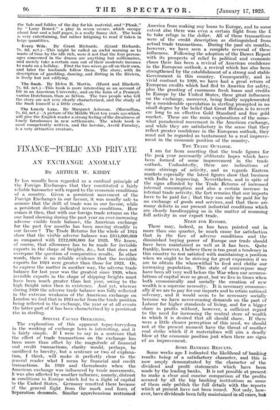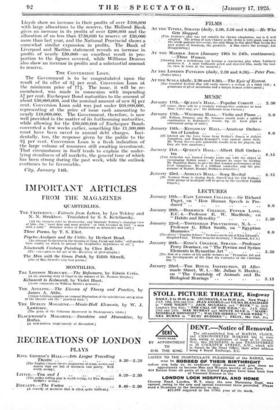FINANCE-PUBLIC AND PRIVATE
AN EXCHANGE ANOMALY
BY ARTHUR W. KIDDY Jr has usually been regarded as a cardinal principle of the Foreign Exchanges that they constituted a fairly reliable barometer with regard to the economic conditions of a country. Given a persistent movement of the Foreign Exchanges in our favour, it was usually safe to assume that the drift of trade was in our favour, while a persistent decline indicated reverse conditions. How comes •it then; that-with- our foreign trade returns on the one hand showing during the past year an ever-increasing adverse visible- trade balance, the American exchange for the past few months has been moving steadily in our favour The Trade Returns for the whole of 1924 show that the visible adverse balance was £344,000,000 as compared with £212,000,000 for 1923. We know, of course, that allowance has to be made for invisible exports in the shape of freights, &c., but that does not overcome the question of comparative results. In other words, there is no reliable evidence that the invisible exports for 1924 were greater than those for 1923. Or, to express the matter in another way, the adverse trade balance for last year was the greatest since 1920, when invisible exports in the shape of shipping freights must have been much greater than last year, owing to the high freight rates then in existence. And yet, whereas during 1920 the adverse trade balance was fully reflected iu the extreme weakness of the American exchange on London we find that in 1924 so far from the trade position being reflected in the exchange, the year or at all events the latter part of it has been characterized by a persistent rise in sterling.
SPECIAL CAUSES OPERATING.
The explanation of this apparent topsy-turvydom in the working of exchange laws is interesting, and it is fairly simple. If I were to say in a sentence that the effect of trade transactions on the exchange has Len more than offset by the magnitude of financial and credit transactions; clarity would, perhaps, be sacrificed to brevity, but a sentence or two of explana- tion, I think, will make. it- perfectly clear to the general reader what I mean by financial and credit transactions. In 1920 and thereabouts when the American exchange was influenced by trade movements, it- was also affected by another influence, namely, distrust In conditions in Europe which led to a flight of capital to the United States. Germany remitted there because )f, the general flight from the mark _and fears, of. Reparation demands. ,Similar apprehensions restrained- America from making any loans to Europe, and to some extent also there was even a certain flight from the £ to take refuge in the dollar. All of these transactions were of the credit description as distinguished from actual trade transactions. During the past six months, however, we have seen a complete reversal of these influences. Following the adoption of the Dawes Report with its prospects of relief to political and economic chaos there has been a revival of American confidence in the European outlook, a revival which has also been strengthened by the establishment of a strong and stable Government in this country. Consequently, and in vivid contrast to 1920, we have had a great return of European credits which had fled to America for safety, plus the granting of enormous fresh loans and credits to Europe by the United States, these great influences on the exchange, moreover, being finally supplemented by a considerable speculation in sterling prompted in no small degree by the belief that Great Britain is to revert ere long to an effective Gold Standard and free gold market. These are the main explanations of the some- what paradoxical movement in the American exchange, and while they are satisfactory in the sense that they reflect greater confidence in the European outlook, they must not be regarded as tantamount to a real improve- ment in the economic position of the country.
THE TRADE OUTLOOK.
I am far from asserting that the trade figures for the past year necessarily obliterate hopes which have been formed of some improvement in the trade outlook. Undoubtedly, there are indications of some stirrings of activity, and as regards Eastern markets especially the latest figures show that business with India is improving. Nevertheless, and in spite of the signs afforded by the Trade Returns of increased internal consumption and also a certain increase in internal trade activity, the fact remains that our imports have to be paid for ; that they can only be paid for by an exchange of goods and services, and that there arc many defects in our present industrial conditions which are clearly handicapping us in the matter of resuming full activity in our export trade.
NEED FOR EFFORT.
There may, indeed, as has been pointed out in more than one quarter, be much cause for satisfaction that in the face of adverse conditions and the diminished buying power of Europe our trade should have been maintained as well as it has been. Quite frankly, however, I believe there is too great a tendency in this country to rest satisfied with maintaining a position- when we ought to be striving for great expansion if we are to obtain the wherewitharto feed and clothe our increasing population. This state of semi-repose may have been all very, well before the War when our accumu- lations of capital were so great, but we live in times when both economically and socially the creation of new wealth is a supreme necessity. It is necessary economic- ally if we are to pay for our imports and to retain national solvency, and it would seem to be necessary socially because we. have never-ceasing demands on the part of Labour for higher standards of living, and for a bigger share in profits without, however, a sufficient regard to the need for increasing the central store of wealth in which it is desired that all should share. If there were a little clearer perception of this need, we should not at the present moment have the threat of another coal strike which if it materializes will aim a deadly blow at the economic position just when there are signs of an improvement.
SOME BANKING RESULTS.
Some weeks ago I indicated the likelihood of- banking results being- of a satisfactory character, and this is - now amply demonstrated by the character of the dividend and profit statements which have been made by the leading banks. It is not possible at present to make a clear and concise comparison of the profits secured by all the big banking institutions as some of them only publish the full details with the- reports which at present have not been issued. Not only, how- ever, have dividends been fully maintained in all cases, but Lloyds show an increase in their profits of over £400,000 with large allocations to the reserve, the Midland Bank gives an increase in its profits of over £200,000 and the allocation of no less than £750,000 to reserve or £50,000 more than last year, and the National Provincial ihowS a somewhat similar expansion in profits. The Bank of Liverpool and Martins statement reveals an increase in profits of nearly £50,000-an excellent result in pro- portion to the figures covered, while Williams Deacon also show an increase in profits and a substantial amount to reserve.
THE CONVERSION LOAN.
The Government is to be congratulated upon the result of its offer of 31 per cent. Conversion Loan at the minimum price of 771. The issue, it will be re- membered, was made in connexion with impending 51 per cent. Exchequer Bond maturities to the amount of about £50,000,000, and the nominal amount of new 31 per cent. Conversion Loan sold was just under £60,000,000, representing at the price of issue cash amounting to nearly £48,000,000. The Government, therefore, is now well provided in the matter of its forthcoming maturities, while allowing for the £80,000,000 of Exchequer Bonds converted a few weeks earlier, something like £1,500,000 must have been saved in annual debt charges. Inci- dentally, too, the response given by the public to the 31 per cent. Conversion Loan is a fresh indication of the large volume -of resources still awaiting investment. That circumstance in itself tends to explain the under- lying steadiness of all markets, the general tone of which has been strong during the past week, while the outlook continues to be favourable.
City, January 14th.











































 Previous page
Previous page